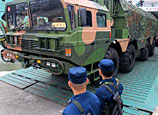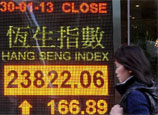
“A project all depending on speed will bring the expected investment returns only when put in a highly efficient place.” That’s why a city in western China was chosen as the seat of the largest foreign investment for a single project since the reform and opening up more than three decades ago.
A scene of red-hot construction met Outlook Weekly reporter not long ago at the site of Samsung Electronics’ factory for 10 nano-level NAND flash memory chips in Xi’an, Shaanxi province, a city not far from the Tsinling Mountains. The company left here more than 100 employees, who would report to the headquarters on project progress by pictures every three days. A Korean responsible person told reporter, “In busiest time we have more than 1,100 engineering vehicles on the site every day, a scene we had never seen before. Our headquarters is very satisfied with the present speed.”
As the largest foreign investment for a single project since China’s reform and opening up more than three decades ago, this memory chip plant, at a cost of US$7 billion for phase I, caused wide attention at home and abroad upon its settlement in Xi’an in April 2012. Given the big money and latest technology in semiconductor involved, why Samsung chose the site in China, and, more than that, in a city of western China? All experts interviewed believed that analysis of this case can help China grasp trends of foreign investment and industrial transfer in the world, and give better play to the nation’s late-comer advantages in a period of new strategic opportunities.
Transnational company eyes China’s domestic demand
Before Xi’an, Samsung, for fear of technology leak, only had one chip production line outside its country, which is in Austin, Texas. “For such a gigantic investment, site selection is a life-and-death decision for an enterprise. Samsung’s final settling in China’s Xi’an is based on its confidence in the Chinese economy and consumption market,” said Zhao Hongzhuan, director of the administrative committee of Xi'an High-Tech Industries Development Zone (XHTZ).
The reporter also felt Samsung’s strategic foresight on China’s huge market as a transnational company. A Korean responsible person told reporter that the decision has caused strong reaction in the ROK, and media opposition was high. But in the eyes of the management, a transnational company like Samsung should place such a project in the country or region of most potential. “China is developing its west and expanding domestic demand, which promise a sizeable market here. Only by basing itself in China can Samsung gradually go to the whole world.”
Presently China produces more than 90% of the world’s tablet computers and nearly 40% smart phones, their use of memory chips, a central component, rising sharply every year, said Feng Zongxian, director of China Association of International Trade and professor with Xi’an Jiaotong University. A Gartner prediction said that China would become the world’s largest chip consumer in 2012 by using 30% of the global production.
Statistics at home showed that so far, China’s largest imports every year is not oil, but semiconductor chips. Samsung expects that China would consume 55% of the world’s semiconductor market shares by 2015. Most PC makers who buy semiconductor products have moved their production lines to China. As a Samsung responsible person put it, “We invest in China because of market and customer needs, the market here is the largest, where customers gather most.”
“Therefore settling in China turned out a natural choice, while the selecting of Xi’an represents a trend of foreign capital moving westward in the country,” said Zhao, adding that as China is vigorously expanding domestic demand, its gigantic market potential has arrested the attention of many an international investor, considering the fact that market is also among the most important resources of tomorrow’s China.
Xi’an as a geographical center of China will be highlighted when one day the domestic demand is boosted, and it can extend to and cover markets nationwide, industry insiders said. In a sense, the arrival of Samsung is not only a chance for Xi’an, but a chance for the company itself in grasping the strategic moment of China’s starting domestic demand market.
Efficiency decides industrial transfer
The Moore’s Law in semiconductor prescribes a cycle around 18 months for a new generation of technology. To stay in lead, investment in this industry is fast, continual and sizeable, with the most fatal regard to efficiency among sectors of modern manufacturing. Samsung’s factory for 10 nano-level NAND flash memory chips in Xi’an in fact represents the world’s latest IT hardware technology in semiconductor.
This is a project all hanging on speed, which brings expected investment returns only when being put in a highly efficient place. In March 21, 2012, Dr. Oh-Hyun Kwon, vice chairman of Samsung Electronics, conveyed this word solemnly to the Chinese side when notifying Shaanxi government of the decision.
In fact, before deciding on China, Samsung also inspected sites in Vietnam, Singapore, Thailand and Cambodia. As it turned out, the governmental efficiency in serving the foreign investor played a critical role.
Supported by relevant authorities, Shaanxi government pulled the project through state examination and approval in only four months and half, from signing contract on April 10 to breaking ground on September 12. Meanwhile, XHTZ as a supportive facility was also approved by nine ministries and commissions in September. A 5.6-km main road for the project was opened; infrastructure including water, electricity, gas supply and roads were in place; more than 10,000 residents in seven villages were relocated in three months; and the 167-hectare central ground for the project were leveled and cleaned up.
“From central, provincial to city governments, fast pushing of the project testified to our institutional advantage in pooling resources for big events,” said Zhao, adding that this has won praise from the Korean government and Samsung. Mr. Jun Jae Won, consul general of the ROK in Xi’an, once said such a project can hardly be started in such a speed in any other country.
This “China speed” also shocked the international community, with European and American countries claiming that China’s semiconductor industry will see leapfrogs as a result.
Low cost plus human resources
Why choose Xi’an instead of coastal cities in the east? A responsible person of Samsung told reporter that here power, water and sewage treatment are 20-30% cheaper, and labor is 40% cheaper. According to Zhao, Shaanxi is a province rich in energies, with better power supply than in the east and as a water source of the state’s south-to-north water diversion is capable of sufficient supply to the project.
Low cost is only one reason, however. For the technology-intensive semiconductor industry, industrial support and cultivation of IT professionals turned out even more attractive to Samsung. Xi’an is a major gathering place of China’s IT industry, being an important base of research, test and education ever since the 1970s. It is home to China’s fist cell phone, first self-developed GPS chip set and technological standards including TD-SCDMA. Presently it houses IT departments in more than 40 higher learning institutions, nearly 50 research institutes and more than 2,600 IT enterprises.
“Xi’an boasts rich human resources and IT supportive facilities. It is China’s third largest education base following Beijing and Shanghai, turning out 17,000 doctors and masters in the IT field every year,” said Zhao. Now Xi’an possesses a relatively complete industrial chain consisting of basic research, application development, design, manufacture and sale.
Applied Materials, the world’s largest equipment provider for semiconductor production, has been in close cooperation with Samsung for years. It set up in Xi’an its largest R&D center outside its home in the US as early as in 2006. Applied Materials CTO Dr. Zou Gang told reporter, “At first we worked together with Samsung in Korea, then we went to Texas, and Samsung followed us by setting up a factory there. We came to Xi’an six years ago, and now Samsung arrives at our heels.”
China is becoming a world manufacturing center of integrated circuit and electronic information amid the global industrial reshuffle as a result of the financial crisis, Zou said, while the industrial foundation in Xi’an can help reduce Samsung’s cost in building industrial chain.
Therefore the project has an amazing radiating effect. In the eyes of Xi’an government, the settlement of Samsung will bring in some 160 supportive enterprises and create 10,000 jobs. This will help improve the semiconductor industrial chain, build Xi’an into an IT base of strong competitiveness, form a regional IT industrial cluster thereby pushing forward the shift in development mode in western China.


















![]()
